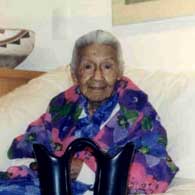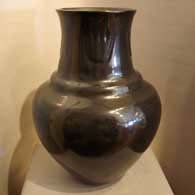
Margaret Tafoya
Santa Clara


Maria Margarita "Margaret" Tafoya, given the Tewa name Gia-Khun-Povi, (Corn Blossom) unintentionally became the matriarch of Santa Clara Pueblo potters. Born in 1904 she learned the traditional art of pottery making from her mother, Sara Fina Tafoya. Her potting style was also influenced by her older sister Tomasita and by her aunt Santana.
Born in Santa Clara Pueblo near Santa Fe, New Mexico, she attended elementary school on the pueblo. When she wasn't in school she could usually be found making pottery. Later she attended Santa Fe Indian School as a boarder from 1915 until 1918. That separated her from the clay for most of the year as she was only home in the summers. When her oldest sister Tomasita died during the flu epidemic of 1918 Margaret returned home to stay with her mother.
Margaret originally created traditional utilitarian red and black vessels. Following the ancient method of coil-building her pottery with clay taken only from the grounds of Santa Clara Pueblo, she continued her mother's tradition of making exceptionally large pots with finely polished surfaces and simple carved designs. Her “bear paw” motif and deeply carved pueblo symbols like the avanyu (water serpent) and kiva steps around the shoulder of her jars are now signature trademarks of Tafoya family pottery. Margaret also used her fingers to impress lines and bear paws into the clay. For deeper designs, she required the assistance of her husband, Alcario Tafoya, whom she had married at eighteen. He would carve designs into the surfaces of her vessels after they had dried at least overnight.
Together, Margaret and Alcario raised thirteen children, many of whom are carrying on the family tradition of pottery making. Her commitment to quality, precision and esthetic simplicity in her pottery has been transferred to subsequent generations of her family. Her granddaughter Nancy Youngblood remembers, "…excellence was the operative word. She raised the bar so high and required the next generation to rise to that level."
Among the matriarchs of Pueblo pottery, Margaret Tafoya's place is unique. She neither innovated a style like Maria Martinez, who originated black-on-black at San Ildefonso Pueblo, nor revived an art form from prehistoric remains like Nampeyo of Hano at Hopi or Lucy M. Lewis who perfected fine line pots at Acoma. She did, however, bind herself to the cultural traditions of Santa Clara Pueblo. Despite changes in styles and techniques over time, she held firm to her faith in the clay. As a result of that commitment, she created some of the largest, simplest and most esthetically pleasing pieces of Pueblo pottery made in the twentieth century.
By the 1960s Margaret's pottery had become famous. She received the Best of Show Award in 1978 and 1979 at the Santa Fe Indian Market. In 1984, the National Endowment for the Arts awarded her a National Heritage Fellowship in recognition of her accomplishments. She was also recognized and received an award as a Master Traditional Artist in 1985.
Margaret's first exhibition was held in 1974 at the Maxwell Museum of Anthropology in Albuquerque, New Mexico. She was honored with retrospectives in 1982 at the Denver Museum of Natural History and in 1983 at the Wheelwright Museum of the American Indian in Santa Fe. In 1984, she was named Folk Artist of the Year by the National Endowment for the Arts in Washington, DC and in 1985 and 1992 received Lifetime Achievement awards. Margaret continued making pottery at Santa Clara until her death in 2001.
Margaret's first and only show held in a gallery was at Andrea Fisher Fine Pottery in 1998. It was her 94th birthday and she was excited but worried no one would come. She was half-an-hour late for the reception and by the time she arrived, the Santa Fe Police and Fire Department had blocked the streets in the area in an effort to control traffic and the crowd: more than 2,000 people were waiting for Margaret. She was so happy, greeting everyone, posing for photographs and smiling through all the attention.
100 West San Francisco Street, Santa Fe, New Mexico 87501
(505) 986-1234 - www.andreafisherpottery.com - All Rights Reserved

Santa Clara Pueblo

Ruins at Puye Cliffs, Santa Clara Pueblo
Santa Clara Pueblo straddles the Rio Grande about 25 miles north of Santa Fe. Of all the pueblos, Santa Clara has the largest number of potters.
The ancestral roots of the Santa Clara people have been traced to the pueblos in the Mesa Verde region in southwestern Colorado. When that area began to get dry between about 1100 and 1300, some of the people migrated to the Chama River Valley and constructed Poshuouinge (about 3 miles south of what is now Abiquiu on the edge of the mesa above the Chama River). Eventually reaching two and three stories high with up to 700 rooms on the ground floor, Poshuouinge was inhabited from about 1375 to about 1475. Drought then again forced the people to move, some of them going to the area of Puye (on the eastern slopes of the Pajarito Plateau of the Jemez Mountains) and others to Ohkay Owingeh (San Juan Pueblo, along the Rio Grande). Beginning around 1580, drought forced the residents of the Puye area to relocate closer to the Rio Grande and they founded what we now know as Santa Clara Pueblo on the west bank of the river, between San Juan and San Ildefonso Pueblos.
In 1598 Spanish colonists from nearby Yunque (the seat of Spanish government near San Juan Pueblo) brought the first missionaries to Santa Clara. That led to the first mission church being built around 1622. However, the Santa Clarans chafed under the weight of Spanish rule like the other pueblos did and were in the forefront of the Pueblo Revolt of 1680. One pueblo resident, a mixed black and Tewa man named Domingo Naranjo, was one of the rebellion's ringleaders. When Don Diego de Vargas came back to the area in 1694, he found most of the Santa Clarans on top of nearby Black Mesa (with the people of San Ildefonso). An extended siege didn't subdue them so eventually, the two sides negotiated a treaty and the people returned to their pueblo. However, successive invasions and occupations by northern Europeans took their toll on the tribe over the next 250 years. The Spanish flu pandemic in 1918 almost wiped them out.
Today, Santa Clara Pueblo is home to as many as 2,600 people and they comprise probably the largest per capita number of artists of any North American tribe (estimates of the number of potters run as high as 1-in-4 residents).
Today's pottery from Santa Clara is typically either black or red. It is usually highly polished and designs might be deeply carved or etched ("sgraffito") into the pot's surface. The water serpent, ("avanyu"), is a traditional design motif of Santa Clara pottery. Another motif comes from the legend that a bear helped the people find water during a drought. The bear paw has appeared on their pottery ever since.
One of the reasons for the distinction this pueblo has received is because of the evolving artistry the potters have brought to the craft. Not only did this pueblo produce excellent black and redware, several notable innovations helped move pottery from the realm of utilitarian vessels into the domain of art. Different styles of polychrome redware emerged in the 1920's-1930's. In the early 1960's experiments with stone inlay, incising and double firing began. Modern potters have also extended the tradition with unusual shapes, slips and designs, illustrating what one Santa Clara potter said: "At Santa Clara, being non-traditional is the tradition." (This refers strictly to artistic expression; the method of creating pottery remains traditional).
Santa Clara Pueblo is home to a number of famous pottery families: Tafoya, Baca, Gutierrez, Naranjo, Suazo, Chavarria, Garcia, Vigil, Tapia - to name a few.
100 West San Francisco Street, Santa Fe, New Mexico 87501
(505) 986-1234 - www.andreafisherpottery.com - All Rights Reserved


